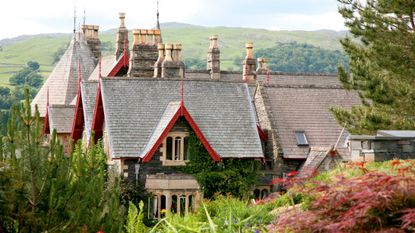Whether you're renovating a house or just performing an exterior health check, ignoring a poorly maintained roof can be disastrous. Just a couple of damaged or missing tiles or slates will quickly allow water to penetrate a building’s fabric, resulting in damage to the timbers and ceilings below.
Where such a problem is left unattended, it will ultimately lead to widespread rot and decay. Then the wind may get under any loose roof covering causing more destruction, eventually needing expensive structural repairs to put things right.

Roofs on old homes should be inspected regularly to check for broken, loose or missing tiles
Roof damage warning signs
As with most common property ailments, early detection of roof damage is crucial to prevent more extensive – and expensive – repairs. Keep an eye out for the following:
- Bits of tile, slate or mortar scattered on the ground or in gutters
- Slipped or broken tiles on the roof
- Damaged or missing metal flashings and mortar ‘flaunchings’ at roof junctions
- Chinks of daylight in the loft space or water stains on the floor of the loft
- Rotten or worm-eaten roof timbers
- Damp patches showing through on upstairs room ceilings
- Slates refixed with lead clips or ‘tingles’ as this suggests the roof covering is failing
- Splits or cracks in flat-roofing materials
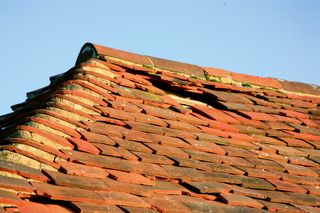
Slipped and missing roof tiles can result in leaks, causing serious damage to a house
How to check your roof
As part of a twice-yearly exterior maintenance routine, look at the roof, preferably using binoculars, to identify potential problems early on. It is relatively easy to check for problems from ground level or, if you have them, from dormer windows and roof lights. This may need to be done from a neighbour’s garden. Methodically examine for slipped, missing or broken tiles.
In addition, pay attention to junctions and places where the roof changes direction. Look for damaged or missing ridge and hip tiles, missing or cracked mortar flaunchings and fillets, as well as corroded or split metal flashings. When these fail, they are likely to let in water, especially around chimneys and at parapet walls.
If there is safe access to the loft examine the underside of the roof for damage, especially when it is raining. Check the floor for water stains or broken pieces of slate or tile. Look out for wet, rotten or worm-eaten roof timbers and try to trace the source of any water penetration.
Other vulnerable areas are junctions between the walls and where chimney stacks penetrate the roof, so note any water staining but do ensure it is current rather than historic – try to do inspections during or after heavy rain. Remember that water tends to travel, so it may not be obvious where the problem is.
While in the roof space, turn off any internal lights and look for places where daylight is coming through the roof covering.
If roof timbers appear to be damaged or under strain a structural engineer or surveyor should be consulted. The undulating quality of a roof does not necessarily indicate a defect but might be the result of gentle distortion and settlement over many years.
Also ensure that roof insulation materials are not blocking the eaves or hampering ventilation in the roof space as this will cause moisture build up.
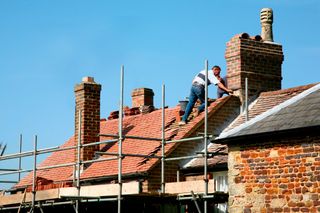
Repairing a clay tiled roof is a job that should be carried out by an experienced roofer
Dealing with roof problems
Roof repairs are generally best left to a professional roofer who understands old buildings and has the appropriate access equipment. Replacing a few tiles or slates is a relatively simple job but it is also important to work out why a problem has occurred and whether it is indicative of a larger failure.
A roofer should be able to undertake minor repairs but it may be necessary to employ a surveyor or structural engineer and a carpenter, all of whom should be experienced in working on buildings of the age and type involved. Remember, that it is very difficult to carry out structural repairs once the covering is replaced.
Avoid quick-fix methods such as spray-on foams and other coatings as they increase the risk of timber decay, prevent proper future inspection of the roof and invariably mean that roof coverings cannot be salvaged for reuse.
Where to find a roofer
- National Federation of Roofing Contractors – roofing trade association with index of members supplying services
- National Society of Master Thatchers – a source of advice for homeowners and where to find master thatchers supplying services
- Lead Contractors Association – index of specialist members supplying materials and services who must work to a code of practice

When re-roofing, the tiles are generally fixed over underlay or roofing felt
Replacing missing roof slates or tiles
Roof tiles and slates can break or come loose due to high winds or impact damage, the failure of fixings, and the action of frost or structural decay of timber roofing members
Action:
- Reinstate or replace any loose or missing tiles and slates
- Check for the failure of other tiles, looking out for signs of cracking or the build up of moss, which can absorb water and increase the weight – gentle brushing down is advisable to control excessive build-up
- Look for signs of ‘nail sickness’ due to rusting or corrosion, or decaying peg tiles
- Examine timber roofing battens and rafters for signs of decay
- Consider re-roofing where problems with the covering extend across the roof
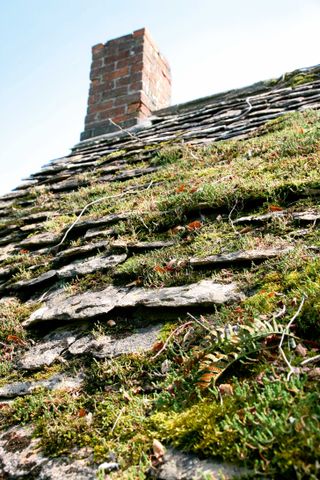
A build-up of moss is a cause for concern, as it can become very heavy and cause damage to the roof
Checking roof junctions
Changes in roof direction and junctions with chimneys and parapet walls are weak points. Careful investigation may be needed as defects can be hard to spot, and moisture often follows unexpected routes.
Action:
- Re-bed damaged or missing ridge and hip tiles in lime mortar
- Repair or replace missing or cracked mortar fillets. Cement mortar fillets are prone to cracking so are best replaced with leadwork
- Repair or replace split or corroded metal roof flashings, ensuring they have sufficient overlap
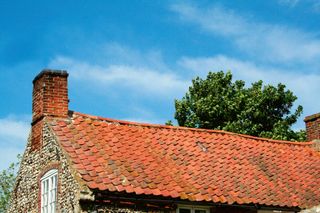
The sagging ridge of this clay pantile roof adds character and is not necessarily a cause for concern
Repairing damaged roof timbers
Beetle infestation, timber decay, poorly executed alterations and undersized rafters are common problems. These are compounded when a roof covering is replaced with a heavier material, such as concrete tiles.
Action:
- Where serious problems are suspected, call in a surveyor or structural engineer
- Employ a good carpenter rather than a roofer to make anything but minor repairs to original roof timbers
- Locate and deal with the cause of damp problems rather than the symptoms
- Ensure good airflow within the loft space and remove any insulation that is blocking ventilation in the eaves
Mending flat roofs
Flat roofs, which may be covered in a variety of materials including lead, copper, zinc, asphalt or bitumen, require regular monitoring.
Action:
- Check for holes, splits and cracks as well as areas where water is pooling
- If necessary, make short-term emergency repairs using mastic or tape
- Where isolated holes or splits occur, patch with matching materials
- Re-fix loose sheet material immediately due to the danger of wind damage

Regularly check thatched roofs for any problems
Maintaining thatched roofs
Thatch should be relatively maintenance-free but should still be regularly checked and, where problems are suspected, a thatcher should be called promptly. Due to the danger of fire, monitoring and maintaining the chimney stack is a priority; the flue should be swept twice a year.
Which roof materials to use?
All roofing repairs are best made using the appropriate traditional methods and using like-for-like materials. Where mortar fillets need to be replaced, lime mortar rather than cement should be used.
Clay tiles: Both hand- and machine-made clay tiles are available. Most tile manufacturers also make ‘specials’ to replace the likes of decorative ridge tiles. While modern tiles have nibs that hook onto the roofing laths, traditional peg tiles have holes to accommodate a wooden peg. Tiles can eventually become porous, making them vulnerable to frost.
Slates: Welsh slates, held in place with nails, have been widely used on buildings across Britain, and are longlasting, lightweight and hardwearing.
Stone tiles: In stone-bearing regions, sandstone and limestone tiles are laid in graduated courses: the biggest at the eaves, the smallest at the ridge.
Lead: An attractive and long-lasting roofing material, repairs to lead roofs should be undertaken by a specialist leadworker.
Thatch: Widely used for centuries, thatching today is generally in either long straw, combed wheat reed or water reed, and there are distinct regional variations in thatching styles.
